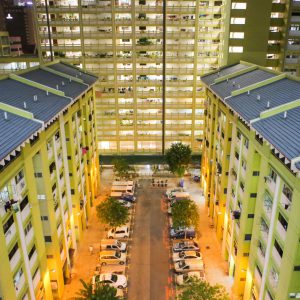No one left homeless: Universal provision of housing in Singapore
October 10, 2021

World Homeless Day, which falls on the 10th of October every year, reminds us of those who may not lead as comfortable lives as the rest of us. 90% of Singaporean citizens and permanent residents live in high-rise flats provided by the public housing authority, the Housing and Development Board (HDB). Professor Chua Beng Huat (NUS Department of Sociology) and Ms Meisen Wong (PhD Fellow at the Technical University of Berlin, Germany) examine the realities behind this universal provision of housing, its relationship to electoral success, and the sectors of society that have fallen through the cracks in ‘No one left homeless: Universal provision of housing in Singapore’, a chapter in Housing Policy, Wellbeing and Social Development in Asia (Routledge, 2018).
With a Gini co-efficient of 0.46, Singapore’s income inequality remains one of the highest among the developed economies. And outside of the top-earners who live on the 15% of available private land, the vast majority of Singaporeans rely on their government’s ability to house them affordably.
The Singapore Government instigated the shift from rental housing to owning flats with a 99-year lease for the majority of Singaporeans in 1964, through what were considered the draconian measures of nationalizing land with meagre compensation to landlords and the start of the Central Provident Fund (CPF) – a mandatory savings scheme where deductions were taken from an individual’s monthly wages and paid as a monthly mortgage to the HDB.
However, later generations of citizens and permanent residents were often locked out of the public housing scheme due to various structural reasons such as low wages, delayed marriage or personal circumstances such as a divorce or separation. Prof Chua and Ms Wong cite housing as one of the critical factors behind electoral losses during the 2011 General Election, as the ruling PAP experienced its greatest loss of popular support since 1959 due to dissatisfaction with housing affordability and issues with immigration.
The article reflects on the subsequent policy measures implemented in order to address the problems of affordability and availability within public housing:
(1) The Total Debt Servicing Ratio (TDSR) was introduced in 2013, requiring that an individual’s total debt servicing ratio, i.e. their mortgage, car loan, credit card debt etc, not to exceed 60% of their monthly income in order to be eligible to purchase and continue financing their public housing.
(2) The Special Housing Grant (SHG) and Additional Housing Grant (AHG), in place since 2006 to assist lower-income Singaporean families to offset deficits in their CPF contributions, were extended to include single people such as tertiary educated women.
(3) The Silver Housing Bonus (SHB) was introduced in 2012 in order to entice elderly home-owners with a sizeable cash bonus to downsize from larger flats to smaller ones.
(4) The Fresh Start Housing Scheme (FSHS) was introduced in 2016 to financially help young families purchase 2-room flats, with the caveat that they must live in the flat for at least 20 years before resale.
The chapter concludes with the returning electoral success for the PAP during the 2015 elections due to the wide-ranging housing reforms and increased restrictions on immigration. However, Prof Chua and Ms Wong draw attention to the nascent and looming class-divide growing among an increasingly class-conscious society and of the preconceptions of living next to low-wage and heavily subsidized neighbours; as one of the interviewees remarked, ‘I don’t know what kind of people will be living in the rental block. What if they commit crimes?’
Read the full chapter here.
